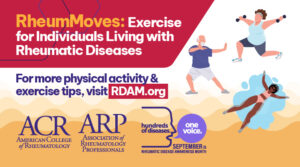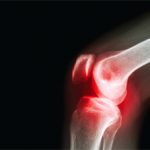 RDAM 2025 focuses on the benefits of exercise for patients with rheumatic disease
RDAM 2025 focuses on the benefits of exercise for patients with rheumatic disease
Physical activity is often an underused—yet powerful—tool to manage rheumatic conditions, says Adam Goode, PT, DPT, PhD, professor, Department of Orthopedic Surgery, Duke University School of Medicine, Durham, N.C.
Dr. Goode is the current ARP president and the spokesperson for Rheumatic Disease Awareness Month (RDAM) 2025. This September, RDAM’s theme, RheumMoves: Exercise for Individuals Living with Rheumatic Diseases, aims to make physical activity a more frequently used tool for patients.

Dr. Goode
“Although research clearly shows that regular, moderate exercise can reduce pain, stiffness and fatigue—sometimes by as much as 40%—many people with rheumatic diseases remain inactive due to fear of worsening symptoms,” Dr. Goode says.1 “RDAM 2025 seeks to close this gap by sharing evidence-based guidance, resources and support to help individuals safely incorporate exercise into their care plans.”
By working with rheumatology teams, patients can develop tailored routines that may boost their function, mood, sleep and long-term health, he notes.
This year’s campaign will include several resources for rheumatology professionals and their patients, including:
- Exercise tips;
- A library of exercise videos;
- Downloadable social media graphics; and
- A fact sheet on exercise and rheumatic diseases.
The resources will be available at www.RDAM.org.
The Role of Exercise
Although rheumatology professionals may understand the value of physical activity, patients often worry about starting a physical activity program, Dr. Goode says. Patients themselves may not be aware of all the benefits that physical activity can offer them. Also patients may think about physical activity but not know where to start, have concerns over flare-ups or worry about the potential for joint damage.
“That’s why rheumatology health professionals are incredibly important for partnering with both rheumatologists and patients for helping to establish a safe and sustainable physical activity plan,” he says.
 Devising a Plan
Devising a Plan
The best move, so to speak, for rheumatology professionals and their patients is to work with colleagues to design a physical activity program and track progress. This approach includes assessing goals and desired outcomes to help patients develop realistic goals. These steps go a long way toward creating a physical activity program patients will follow.
Many patients may choose a low-impact, aerobics program, such as walking or cycling, Dr. Goode says. Others may choose strength training or a combination of the aerobics and strength training.



